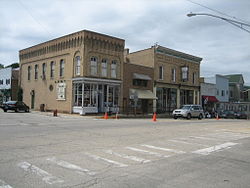2010 census
As of the census [11] of 2010, there were 1,901 people, 415 households, and 285 families residing in the village. The population density was 802.2 inhabitants per square mile (309.7/km2). There were 441 housing units at an average density of 324.3 per square mile (125.2/km2). The racial makeup of the village was 97.89% White, 0.27% African American, 0.18% Native American, 0.64% Asian, 0.92% from other races, and 0.09% from two or more races. Hispanic or Latino of any race were 4.03% of the population.
There were 415 households, out of which 35.2% had children under the age of 18 living with them, 56.4% were married couples living together, 8.9% had a female householder with no husband present, and 31.3% were non-families. 25.1% of all households were made up of individuals, and 9.4% had someone living alone who was 65 years of age or older. The average household size was 2.63 and the average family size was 3.19.
In the village, the population was spread out, with 27.3% under the age of 18, 7.3% from 18 to 24, 29.9% from 25 to 44, 22.6% from 45 to 64, and 12.8% who were 65 years of age or older. The median age was 37 years. For every 100 females, there were 99.1 males. For every 100 females age 18 and over, there were 96.3 males.
The median income for a household in the village was $52,361, and the median income for a family was $60,417. Males had a median income of $41,136 versus $27,344 for females. The per capita income for the village was $22,332. About 2.6% of families and 6.5% of the population were below the poverty line, including 4.4% of those under age 18 and 10.2% of those age 65 or over.



